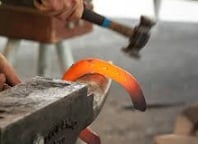In order to know the meaning of the term blacksmithing, it is essential to discover, first of all, its etymological origin. In this case, we can establish that it derives from the word blacksmith, which comes from Latin, specifically from "ferrarius", which means "one who works with iron" and which is the result of the sum of two very different lexical components:
-The noun "ferrum", which can be translated as "iron".
-The suffix "-ero", which is used to indicate "trade" or "profession."
Blacksmithing is the activity of the blacksmith : the individual who is dedicated to working iron . The workshop and commercial premises of these people are also called blacksmiths.
 Iron is a malleable and ductile metal of great tenacity that, in addition to being part of substances essential for life, is the most used material at an industrial level. Blacksmithing is linked to the artisanal work carried out by the person in charge of forging it.
Iron is a malleable and ductile metal of great tenacity that, in addition to being part of substances essential for life, is the most used material at an industrial level. Blacksmithing is linked to the artisanal work carried out by the person in charge of forging it.
Generally, iron is subjected to a heat source so that, when it reaches the necessary temperature, it can be molded due to its acquired malleability. With hammers and other instruments, the blacksmith expert gives the metal the shape he wants.
The blacksmith must pay attention to the color that the iron takes on due to the action of heat, since that tone indicates whether it is now possible to advance with the forging or not. The metal, when heated, turns red and then mutates to yellow. It is common for blacksmith workshops to have little lighting so that the blacksmith can easily observe these changes.
Among the tools and devices used in blacksmithing, there are the forge (the place where the iron is subjected to heat), the forge (the stove), the tongs (to manipulate the incandescent metal) and the anvil (a metal block on which is hammered).
Railings, sculptures, ornaments, bells, pieces of furniture, weapons and kitchen utensils are some of the products that are made through blacksmithing. Many times the finish of the work determines its value.
In the same way, we cannot ignore what is known as Herrería de Compludo. The Leonese town of Compludo is where this place is located, which has become one of the best examples of medieval industry that has managed to be preserved over time.
In the 7th century, according to various theories, this space has its origin, associated with the founding of the Complugo Monastery by San Fructuoso, which allows us to know the way in which the forge was used to shape a hydraulic system.
Furthermore, in Seville there is a unique accommodation that responds to the name of Suites Herrería de la Maestranza. In the heart of the city, specifically on General Castaños Street, this set of apartments is located to offer visitors a comfortable place to rest during their stay in the city. An enclave that takes as its building the old Atarazanas complex, which dates back to the 13th century and was the Crown's naval factory.
